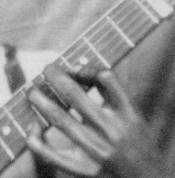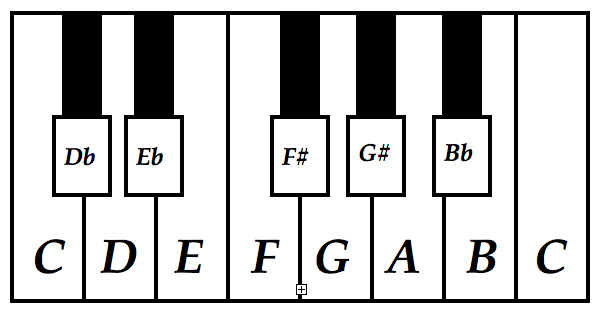wiki ~ Charley Patton ~ wiki ~ Bessie Smith wiki ~ Jimmie Rodgers ~ wiki ~ Robert Johnson ~ glossary ~ blues components ~ ~ blues guitar method ~ E A D G B E ~ ~ blues guitar method open 'G' ~ (D) G D G B D ~ ~ 12 bar blues chord progresions / major ~ ~ 12 bar blues chord progresions / major ~
|
Blues 'start' nutshell / dominant V7. The principle harmonies of most of the blues we hear over the last 100 years of so are of the dominant / V7 chord family. These dominant chords are the 'traffic cops' in songs with more of a traditional, diatonic harmony scheme. In the blues' traditional 12 bar form, it's three principle chords; the One, Four and Five chords, are all dominant V7 chords. So each contains a 'two pitch' tritone interval which generates the energy to move things along. That each of these 'paired tritones' are different from one another becomes the challenge we want to understand and master; both in melody and harmony. Blues 'start' nutshell / 12 bar form. In learning the blues and practicing to get better, we can work blues songs through from beginning to end, playing from root pitch to root pitch of its principle chords. Add in the clicks of a metronome to the bass notes and chords (arpeggios) for 12 bar blues song form, and we've the basic elements in place for your own talents to blossom by the energies you put into it. Mastering the 12 bar form solid (three 4 bar phrases), is the trick, for it solidifies our sense of form, natural phrasing like speaking, and perfect closure in creating complete songs, all within a predictable form now shared by many the world over. Master the predictable. By mastering 12 bar blues we gain insight into the definite begin and end points of a 'closed' musical form, that it happens to also be predictable gives the aspiring artist a way to both strengthen abilities to thing 'ahead' in the music and build confidence in getting through the turnaround and into a new chorus; set of 12 bars. These two skills; to think ahead a bit and get through the turnaround back to the top of the form both apply in big ways to whatever 'forms' of songs might come along next, for both shaping melodies and looping chord progressions; eight and 16 bar songs, the four / eight bar phrases of rhythm changes; the 32 bar form 'A A B A' of sonata allegro form for hundreds of jazz standards, sweetens then seals the deal for learning the blues songs found in any of our styles and genres :) |
In theory beware :) In starting out to understand the pitch relationships and theory of the blue colors in Americana musics, know that when we analyze its component parts we're going to find fairly big 'breaks' with our Euro diatonic theories of scales and chords, theories that in general govern the majority of our consonant leaning music styles and genres; folk, pop, rock, country and into jazz. For at the heart of the blues, blue note pitches will strongly clash with one another on purpose, i.e., they're oftentimes dissonant to the chord they are supported by.This 'blue aural' is often termed here as the 'blues rub' or the 'other five pitches', strong blues melody notes are very often not included in supporting chords, so there's no diatonic basis as in the Euro sense, while the chords, through their color tones, also take on provocative dissonant quality as well, as the blues chords dearly love 'V7' and its built right in two pitch tritone interval. In some jazzed up settings, its the blues' rhythms and especially its 12 bar song form that are the saving grace that keeps it all together, moving the members of the band grinding toward a new goal; found at the super predictable top of the form, when a new round or chorus of 12 bars begins and the journey continues. The essential '12/8' triplet feel atop a steady 4/4 march beat, combined with a rock solid 12 bar form, will win the day with near any combination of selected melody notes and supportive harmony. Hipsters can, and will, shape any sort of musical idea into a 12 bar blues. So that's where we start our studies here. Simply by sounding them out together, blue melody notes over supportive chords, as stark as this e-book allows. |
Author's note. For those readers / learners here who get bit by the 'solo through the changes bug' of the jazz leaning realms, eventually it may come to light that the blues, and its 12 bar form, provides the vehicle for finding, shedding and mastering the melodic nuances of soloing through any chord progressions including chord substitutions within the 12 bar progression; if we can 'fit' something in a blues and make it musical it'll prolly work in other spots and in other forms and songs as well; blues licks in two and four bar vamps, 8 bar form, and chord substitutions into the progressions of the 16 / 32 bar song forms of many Americana standard songs. And if there was any doubt here in regards to the 'blue potential of all things cool', a browse through the bebop primer; the Charlie Parker Omni Book, reveals to us that of the 142 pages, 51 are devoted to transcriptions of Parker's 12 bar blues ideas; lines, harmony and chord substitutions within the 'set in stone 12 bar form'; so nearly 1/3rd of this essential collection of improvisation of pure Americana bebop is 12 bar blues ... so if ya ever need a new blues lick or two, a bookfull awaits ... :) |
Learning the blue notes on piano. Built right into our piano keyboards is the relationship of the blue notes in a diatonic key center. Please examine the following illustration of the piano keyboard. Thinking 'C 'blues. Example A.
'C through the octave to C' on the white keys, get's us the 'C' major scale. On the black keys, we locate the blue notes in relation to 'C' major scale / the key of 'C' major. Supported by the dominant 'C7', the common tonic chord in blues, listen to each of the blue melody notes sounded over this harmony. Example A1. |
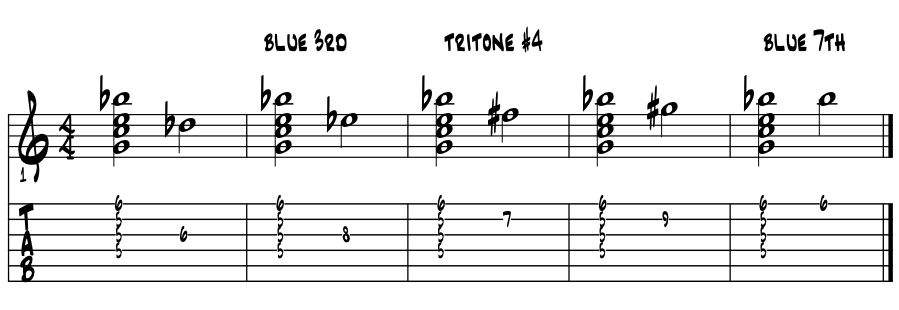 |
The ones that really count. While there's five blue notes in theory, in practice we lean heavy on just three in making blues melodies. Let's go through the five and bold up the main three. Example 2. 1) 'Db' / 'C#' / 'sharp One.' Rare in melody unless we bend hard on the 'C' towards 'Db', or even a wide vibrato gets us there. 'C#' is needed to make a special chord within bluesy chord progressions, a Six chord, which is Five of Two. So in building up an 'A7' chord, 'C#' is jazzy leaning cool. 2) 'Eb'. Super potent 'blue third.' Beyond essential, learn its blues rub here and now if need be. Honk this one every chance to fill the dancefloors. 3) 'F#'. Super potent 'tritone.' Jazz players get here more often in their melodies and in traditional styles, the tritone is more of a passing tone to Four below, or Five above. The tritone is generally our most dissonant melody pitch which easily bends up to Five, our second most consonant, go figure and welcome to the blues :) 4) Sharp five / #5 / 'G#' / 'Ab'. On the rarer side in melody as a passing tone between '5 and 6.' Bending the notes changes everything of course, just explore its colors by 'pushing' the 5th around, very common in blues rock, where lighter strings often win the day. In harmony, 'G#' augments the tonic triad, usually a passing chord color when moving to the Four chord. 'Ab' is the minor 3rd a minor Four chord, often a passing chord in blues songs. 5) 'Bb'. Super common 'b7.' The 'b7' note is a potent melody note as it's so close to the tonic pitch. Melodies to 'suspend' the sense of forward motion, lean on the 'b7' to grind the line. In the chord, 'b7' ensures the tritone within any V7 chord. Cool ? Find a piano and master these blue note energies over the root pitch as shown above. Sing these blue pitches and learn the blues rub. Then find your vocal quality on any instrument. And viola :) |
Learn these blue notes on guitar. History tells us that we can go back a century in our musics by turning our guitars into more of a banjo, retune it, and marvel as the original blues strains are easily coaxed forth with a push of a finger and activating the motor hand. Want to go back 100 years in time :) Just loosen the low 'E' string and get it out of the way for a moment. Retune the remaining five strings to open 'G.' Play through this example sounding out the blues notes over and with the open strings, tuned to an open 'G' chord. Talk about pure magic :) Example A2. |
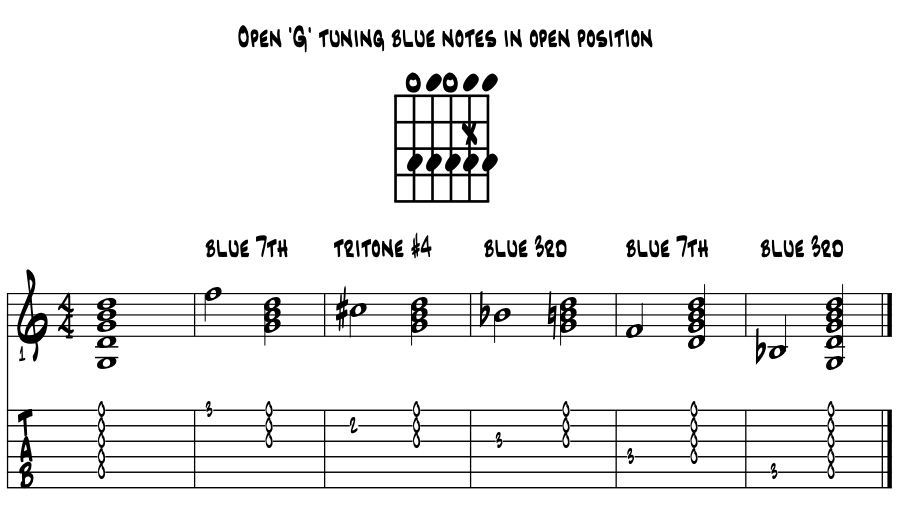 |
Well ? Did those blue notes jump right off the neck or what ! Got to be the easiest riff in the book, when tuned to open 'G' that is. Plus, we learn some banjo along the way. Sing the notes to master the magic here, of the blue notes and their energy. Also, while tuned up open, try these licks with any sort of handy slide; slide around the 3rd fret, then whomp the open strings with a thumping motor hand. With a slide. Third fret brings blue notes, fifth the 'C' chord and 7th fret the Five chord 'D.' Slide up to the 12th fret to find the octave 'G', 10th will be flat Seven, 7th, 5th and 3rd then open strings and the 'hands of time' will have been turned :) Author's note. Please know that this open tuning approach to the blues is the historical source of what we do today, in creating the wide array of blues music styles as well as adding in the blues hue anywhere along our melodic ways. In the early 60's, a rocker in London picked up on the 'open G' vibe and never looked back, going on to write a few rock anthems with this now ancient open tuning. |
'Muddy' walkdown. We're back in six string standard tuning; so ... 'E A D G B E .' This next idea is very common in the blues music. Named here for blues artist Muddy Waters, it'll work every time in lots of different spots in songs to keep things humming along. Rote learn it here if need be, adding your own accents. Thinking 'blues in G' and starting on our root pitch 'G.' And in the true testimonial process, no question where this line is a going :) Example 1. |
|
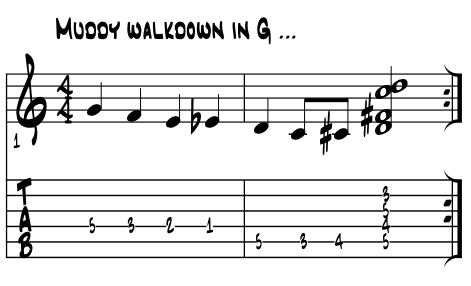 |
Cool? Lot of 'direction to' in the line, pretty definite sounding to where its going ? Right on yea it's supposed to be, 100 years on down it's a cliche now. Super super common lick for 'bars 11 and 12' in any 12 bar blues. Once under your fingers, learn it in a couple of more keys; 'E, A, C', are common. Flat keys for working with horn players usually. So 'F', 'Bb' etc. Maybe write a song in each one ? And surely rote this lick if need be. Also, do find this pattern in 'G' blues in a few spots on the neck. Anywhere there's a 'G' note on your ax, this lick is nearby. For it'll get you riding the neck on the blues elevator, for that feeling of 'going up.' |
'In from the Five chord. An easy way to kick off any 12 bar blues is to play a four bar intro that starts of the Five chord of the key of the tune. in 4/4 time, a measure of Five, a measure of Four, then the turnaround just shown above. Pro players will 'walk' into the chords, most common by half step, helps define the key center. |
'Muddy' walkdown chords. In this next idea we play chords for the walkdown notes, three key centers from each of the low bass strings. Chords in standard tuning. Example 1a. |
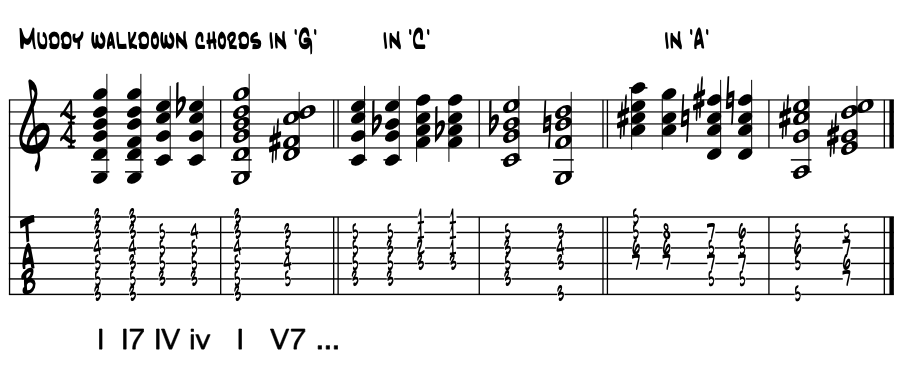 |
Reverse 'Muddy' walkup. In this next idea we reverse the direction of the line from our root pitch 'G' and it still works perfect. Again, thinking blues in 'G.' Example 2. |
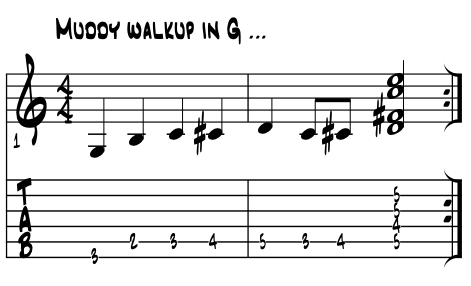 |
Getting down to bottom of things here pitch wise, this idea, actually both the descending and ascending, make great bass lines too. So share them with your pals and turn up some blues ! The closing 'D 9' chord is a common blues, jazz and funk chordal color for turnarounds. |
| 'Howlin' lick. In this next idea we outline the three chords of blues song. This basis triadic motif can go about a couple of dozen different ways. Named here for bluesman Howlin' Wolf himself, this is one of our traditional blues guitar riffs. We reverse the direction of the line and it still works fine. Here thinking blues in 'A.' One / Four / Five / One. Example 3. |
 |
Three chords and the truth? Yep, just a shorthand sort of four bar version of the 12 bar blues form truth. Lots of variations with triads so explore and experiment. Got a story to tell ? Shape these triads as you need to, they make easy bass lines and motorize to make your songs. |
Root to root 12 bar blues. Of all of the musical forms we inherit today, the four bar phrase is the core of nearly all. In the 12 bar blues, we simply create an idea of four measures, we then repeat it three times to make a song. In the following chorus, we'll just sound the root pitch the One, Four and Five chords and jazz it up with a 'fast Four' move. Same One, Four Five as the last idea? Yep, but now back in 'G blues.' Example 4. |
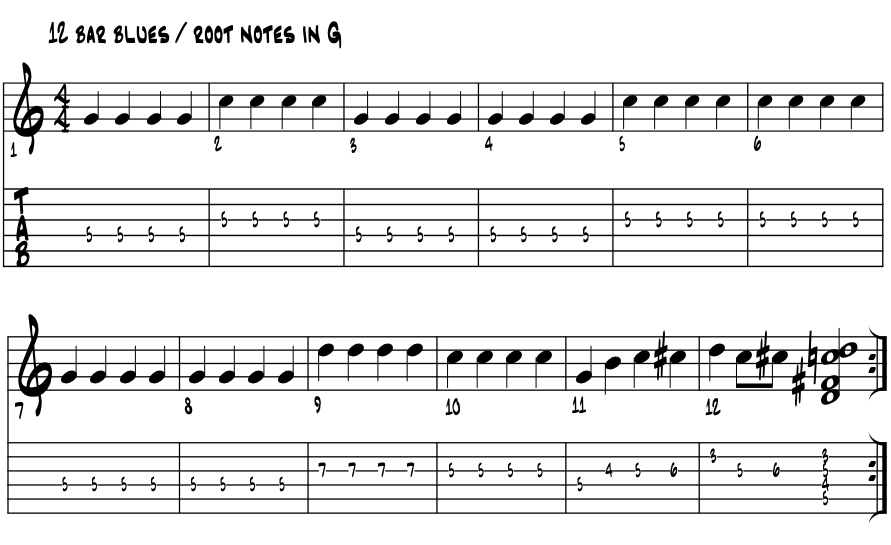 |
Sound familiar? Scoots right along huh ? Yep, it's at 180 beats per minute. Dig the turnaround in the 12 bar? We've been hearing this sort of line for near seven decades now in our Americana musics. The 'Batman' theme comes to mind. Here's an arpeggiated version of the triads. Just rockin' around the clock. Example 4a. |
|
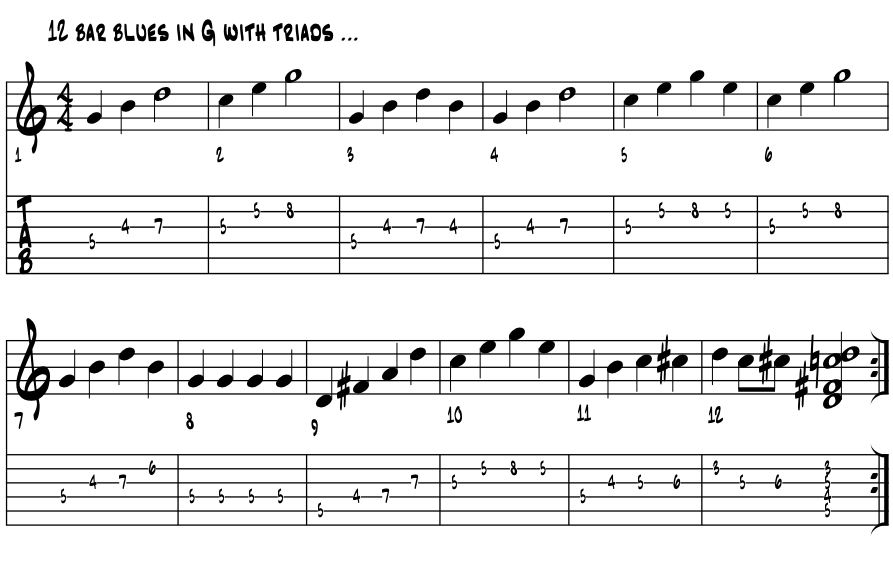 |
Master this last 12 bars and string a few choruses together. Internalize the sounds and form, own them forevermore globally. Once under your fingers, add the 7th colortone for each triad to jazz it all up and bring a deeper blues hue to your cool. From there the '9's, '11's and '13's will beckon. |
The 'muddy' lick through 12 bars. This next idea, for beginning blues leaning artists, is a game changer. Here we take the 'muddy' licks from above and create a 12 bar blues form / song. Master this 12 bar song, even in just the one key, and a 'ton' of musical skills will begin to fall in place. Run it through a couple of keys and begin to knit this puzzle together over your fingerboard. While it is a bit tricky at first a lot of these guitar / bass licks come right off pro recordings. Example 5. |
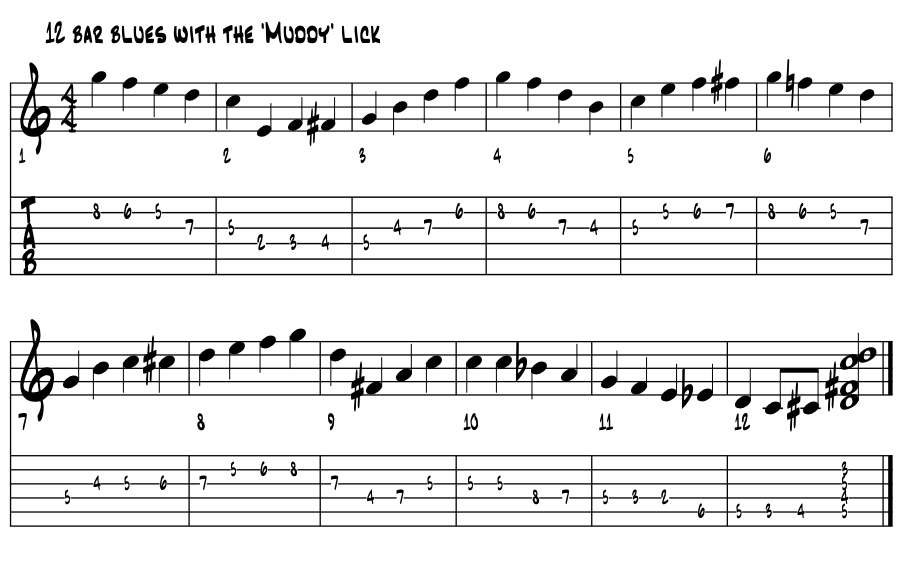 |
Learning some four string bass too along with six string guitar? Thoroughly mastering this last idea might just get you some gigs. For now you've a musical form to work with and cool lines to connect up the dots. A song's form is what gets the band on the same page together, and keep them there as the stories unfold. Twelve bar blues is a base we build songs of all the styles upon. |
Honky tonkin' 12 bars a la boogie woogie. Once the triads are cool, our next evolutions is to add a blue 7th to each of the triads. In doing so we create the coolness of 'jump' musics that gave rock and roll its first few go's. And what key are we in ... ? Example 5a. |
|
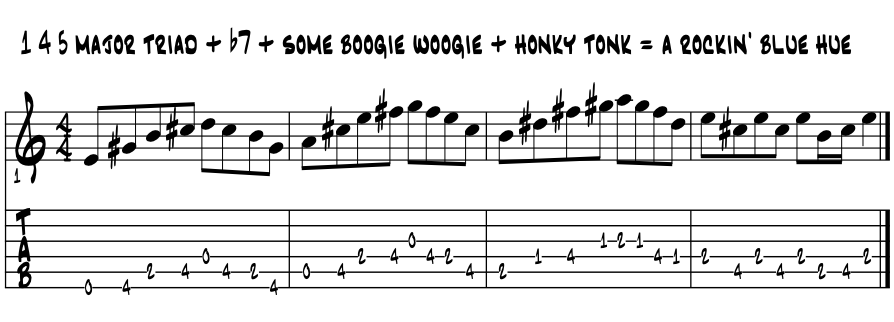 |
Cool? Sound familiar? Cool. And yea, key of 'E' blues. Jazzed it up a bit with the 6th too. Blues rockers of all the stripes should master this last idea in a couple of keys. Easy pattern to follow, easy way to get a room up dancing :) |
|
Find a mojo lick ~ 'minor penta blue.' Here we go back to the basics. Every blues inspired artist needs their own mojo lick, a lick they can blast into the mix without a moments hesitation. It's just super super solid under your fingers and because, you invented it, it's yours. Even if ya mess it up sometimes it'll still be yours, variations are cool and help us evolve; things change. And chances are you'll go back to it a time or two again and again and it'll evolve over the years too. |
So the trick is to find it. One way to start is to run this scale shape's pitches ascending and descending, till your muse shakes an idea loose in your lines. Stop anywhere along in the pitches and search if you hear some coolness. Just search find it. And in the meantime, as we run these pitches / scale shape up and down, we also are rote learning the original, core of it all, 'box' scale shape. Here in blues in 'A', run this blues scale shape up and down the pitches, in position, and find yourself a mojo lick or two along the way. Mostly around the 5th fret puts us in 'A.' Example 6. |
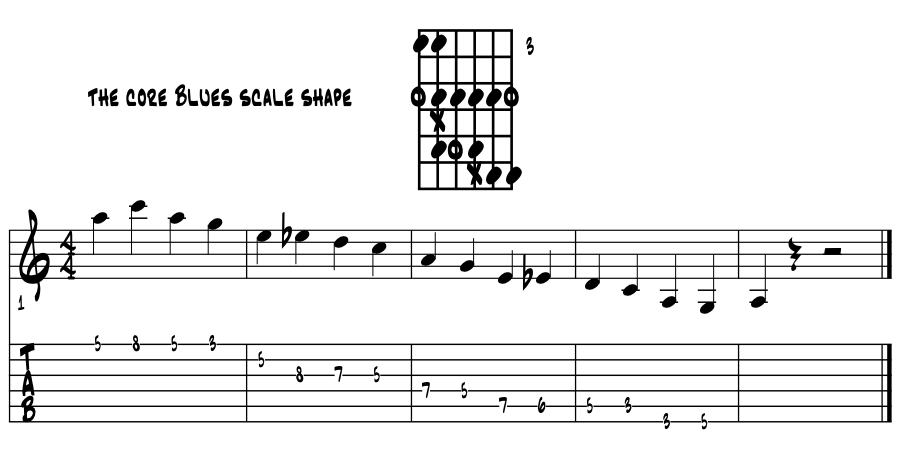 |
Find something? Cool. The 'x's ? The tritone blue notes. And is this the one scale shape we all use? From the brightest stars on the scene to garage bands, and on through all the ten decades or so now ? Yep. This one shape yields bushel baskets full of great ideas every day. And has for the last couple of hundred years or so, for countless blues leaning artists with every sort of genre. Rockers, country, even jazz. Every Americana blues leaning guitarist will know something of this shape and its pitches. A totally movable form and shape and basis for the blues 'elevator', begin to learn it here and now if need be, master it and its yours too forevermore :) What's not to love ? And within a six fret span, this shape includes all 12 paired key centers, their modes, intervals and arpeggios and chords so the whole tamale, are within this collection of pitches, and all in tune too till the bending begins ! And of course there's gotta be a next floor up a ridin' on the blues elevator ... going up ? |
Two chords two ways. With the 12 bar blues, we can start out by forming up its three chords, the One, Four and Five chords, with two voicings that get us through the form, and by thinking from the root pitches, using the same chord shapes to get us through two popular blues songs keys. Example 6a. |
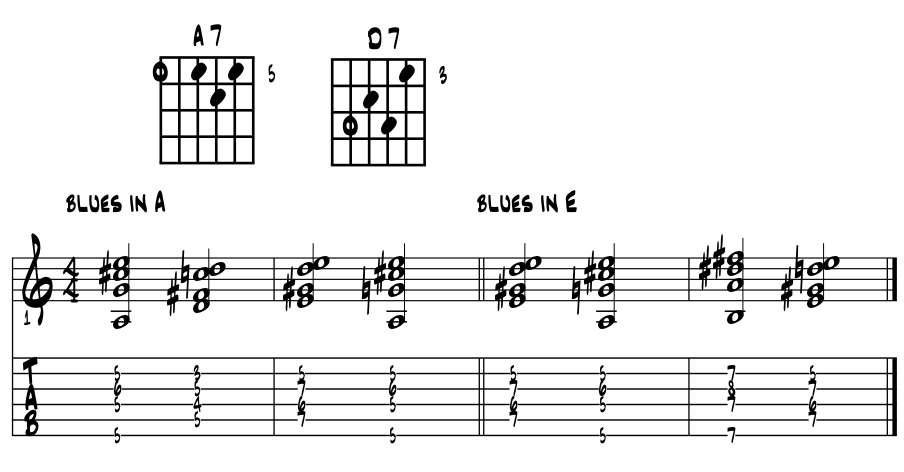 |
Move these root position chords around to give you the One, Four and Five chords. The tab clef gives us the correct fret numbers too :) |
A first full diminished 7th chord lick. So much of what we do in mixing up the blue colors and its hues, and blending them into all of our Americana musics, revolves around the tritone interval. Encapsulated into the pitches of V7, we easily can further build up the tritone colors into diminished triads and chords. And while a rare color indeed in the folk toward pop musics, in the blues and especially jazz, the diminished colors opens the Giant's doors into new realms of creativity and explorations. Know this sound yet ? Example 7. |
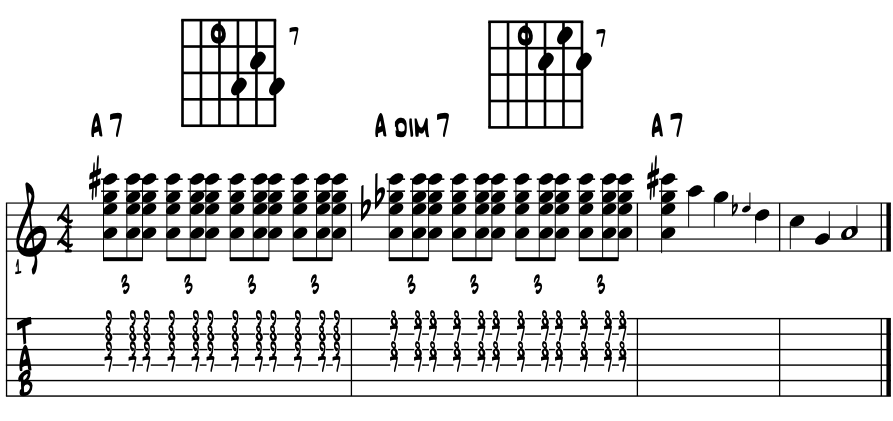 |
A first diminished chord lick. This last idea goes way back now to the early blues. Notice how the voicing just sort of collapses on itself to alter the color? Collapsing the intervals of a chord, in this case with V7, evolves the diminished color for us. |
Write a blues song. Well did you shake loose a mojo idea from the scale shape and it's pitches from the entry above ? Find some words to express an idea for a song? Maybe a hook shook loose with the pitches and lick you found ? Cool. Can you make it all into a four bar phrase? Even cooler then, let's write us a 12 bar blues song. Just take your four bar idea and repeat it three times over the form and chords of a regular old, 12 bar blues song and viola ... your blues song is born. |
Still searching for the coolness within? Need an idea? A bluesy, testify, I know this story too, took a piece of my heart now, blues hued and feels good too in a way ? Easy. Borrow one of mine. Here's some of my words for a hook / chorus for your song, one's that everyone in the band can sing too. "The truth is ... ya just don't love me no more." "The truth is ... ya just don't love me no more." "The truth is ... ya just don't love me no more." Here's the pitches. Example 6. |
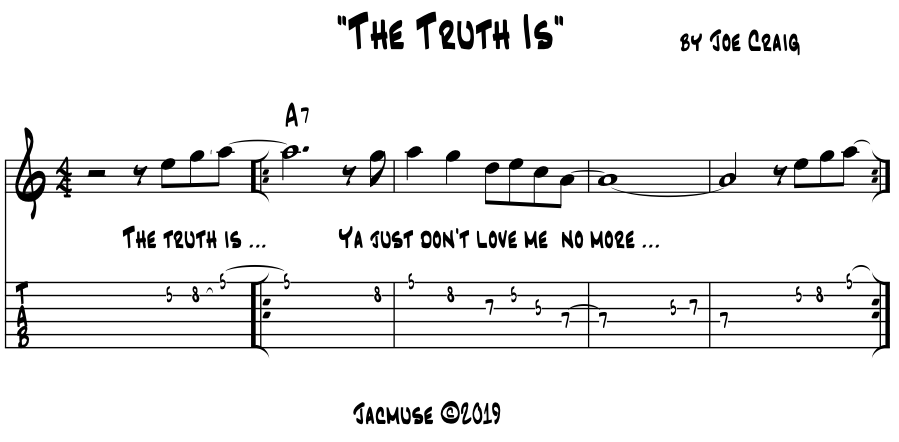 |
Three's a charm eh ? My first verse starts ... 'There was a time ... " Second verse ... "Please tell me now ... ' What U got ? Have some blues rhymes ? |
Think you can now write a four bar phrase into a 12 bar blues form? Very cool, and a super super theory game changer for certain :) For any moment on anyday, the blues can along along and say ... 'write me a song about life indeed, makin' it true and blue indeed.' |
Review. So, have a few licks under your fingers with our blues colors now? Each of the ideas presented above create ways to play the blues. And nearly all of the shapes for scales and chords move right up and down the neck, along the way finding the good keys for singing the blues songs. Same basic shapes for the open position and thus the 12th fret, home of so many many a 'blues in E' monsters. |
In time. Learning blues takes some time, be patient. And talking time, team any up with Franz, and let your strengthening begin anew. For within musical time the magic of the 'muddy lick's pitches and sequence set the direction and destination that all within hearing seem to intuitively understand :) |
References. References for this page come from the included bibliography from formal music schools and the bandstand, made way easier by the folks along the way. In addition, books of classical literature; from Homer, Stendahl and Laudurie to Rand, Walker and Morrison and of today, provided additional life puzzle pieces to the musical ones, to shape the 'art' page and discussions of this book. Special thanks to PSUC musicology professor Dr. Y. Guibbory, who 40 years ago provided the initial insights of weaving the history of all the fine arts into one colossal story telling of the evolution of AmerAftroEurolatin musical arts. And to teacher-ed training master, Dr. Joyce Honeychurch of UAA, whose new ideas of education come to fruition in an e-book. |
"Blues is based on the common ground shared by all people, black and white, young and old. Blues is the story of the human life, of its loves and struggles. All rock and roll, all jazz, all American music finds its roots in gospel music and the blues. |
wiki ~ Howlin' Wolf |
Find an e-book mentor. Always good to have a mentor when learning about things new to us. And with music and its magics, nice to have a friend or two ask questions and collaborate with. Seek and ye shall find. Local high schools, libraries, friends and family, musicians in your home town ... just ask around, someone will know someone who knows someone about music who can help you with your studies of the musical arts with this e-book. |
Intensive tutoring. Luckily for musical artists like us, the learning dip of the 'covid years' can vanish quickly with intensive tutoring. For all disciplines; including all the sciences and the 'hands on' trade schools, that with tutoring, learning blossoms to 'catch us up.' In music ? The 'theory' of making musical art is built with just the 12 unique pitches, so easy to master with mentorship. And in 'practice ?' Luckily old school, the foundation that 'all responsibility for self betterment is ours alone.' Which in music, and same for all the arts, means to do what we really love to do ... to make music :) |
 |
"These books, and your capacity to understand them, are just the same in all places. Always bear in mind that your own resolution to succeed, is more important than any other one thing." |
|
Academia references of Alaska. And when you need university level answers to your questions and musings, and especially if you are considering a career in music and looking to continue your formal studies, begin to e-reach out to the Alaska University Music Campus communities and begin a dialogue with some of Alaska's finest resident maestros ! |
|
Formal academia references near your home. Let your fingers do the clicking to search and find the formal music academies in your own locale. |
"Who is responsible for your education ... ? |
'We energize our learning in life through natural curiosity and exploration, and in doing so, create our own pathways of discovery.' Comments or questions ? |
